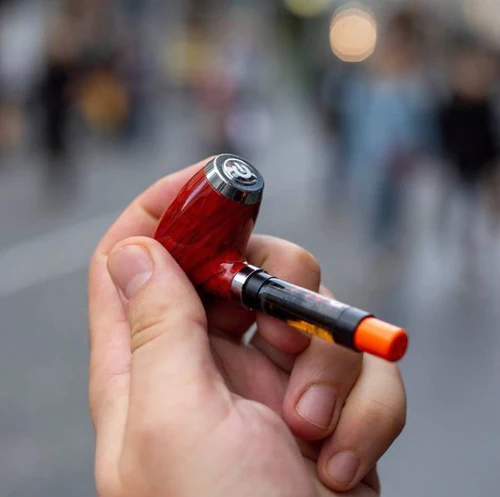The pipe market has an astounding diversity of options, enough to even baffle experienced smokers when determining the specifics of their upcoming acquisition. For novices, the array of choices can appear daunting. Nonetheless, equipping oneself with a modicum of knowledge regarding the available consumer options can significantly simplify making a well-informed decision when purchasing your inaugural pipe.
What Is a Pipe?
A pipe symbolizes a hollow, cylindrical conduit transporting fluid materials, including liquids, gases, fine powders or tiny solid particles. The operational robustness of a pipeline system is contingent upon various factors and considerations involved in its blueprints - such as the type of material utilized in its construction, its capacity to endure varying degrees of temperature and pressure, and the specific substance it is designed to transport.
Various Smoking Pipe Materials
Various essential substances are employed in the production of tobacco pipes, with Briarwood standing out as the most common. Alternative substances such as meerschaum, corn cobs, and clay have also been applied to fabricate smoking pipes.
Briar Wood Tobacco Pipes
Briarwood is the most frequently used material in crafting tobacco pipes. Its popularity stems from its durability, heat resistance, and breathability, making it an ideal material for pipe construction.
Briarwood's porous nature lets it absorb the heat and oils produced when pipe tobacco is burnt. This type of wood is sourced from the roots of Erica Arborea trees, commonly found near the Mediterranean Sea.
Meerschaum Tobacco Pipes
Meerschaum, one of the most high-priced materials used in pipe creation, originates near the Black Sea in Turkey. This material's unique carvable quality allows for elaborate designs, which can raise the cost of the pipes.
Despite the steep price, these pipes are highly coveted for their excellent smoking quality and aesthetic appeal. Meerschaum pipes are known for their lightweight construction and the cool, smooth smoke they produce.
Corn cobs, or simply 'cobs', are the most affordable and readily available material for pipe manufacturing. Pipes made from dried and hollowed-out corn cobs are fitted with a stem to channel smoke from the bowl (the cob) to the smoker's mouth.
Types of Hand Pipes
Chillums / Single Hits / Cigarette Accessories
These represent the most rudimentary forms of glass pipes. Identifiable by their simple glass tube appearance, these pipes are popular for their ease of use. Users fill the pipe's end with their chosen material and ignite it. This straightforward design makes it convenient for users who are constantly on the move. However, the absence of a carburetor in this style of pipe limits the quantity of herbs that can be packed into the bowl.
Advantages: Compact bowl for smaller herb quantities, easy to carry and conceal.
Drawbacks: The absence of a carb hole results in less satisfying hits, less potent hits. The small bowl may be a disadvantage for those who wish to smoke more.
Spoon Pipes
Spoon pipes are likely the most favored hand pipes. They are a progression from the basic chillum, typically featuring a carburetor that enhances the control of your smoking experience by introducing ambient air to your smoke, thereby altering the smoke/air blend's density.
These pipes are designed to comfortably fit in your hand, resembling a tapered "spoon" used for eating. Given their size, these pipes are straightforward to use. Simply fill the bowl with your choice of herbal blend or tobacco, and you're all set. The Glass Spoon pipe is available in a multitude of colors and patterns.
Advantages: More comfortable to hold and use due to its size, accommodates more material in the bowl, and features a flat spot on the bottom for easy placement. The carb hole facilitates deeper smoke inhalation.
Drawbacks: Prone to breakage, can get blocked relatively easily.
Sherlock Pipes
The Sherlock pipe, named after the famed literary character created by Doyle, is characterized by its large bowl and elongated, curving stem. Depending on the specific design, it may also feature a third hole, which serves the dual purpose of facilitating cleaning and controlling airflow. The pipe's design ensures that the smoke is dry-filtered, as the ash produced in the bowl, being denser than air, collides with the side of the glass near the bend and adheres to the interior of the pipe. Advantages of this design include a longer stem, which effectively filters the ash from the smoke before it reaches the user's mouth. The extended shape also keeps the lit plant matter at a safe distance from the user's face. Additionally, some models feature a carb hole, which enhances the quality of the hits and simplifies the cleaning process. However, there are also potential drawbacks to consider. The extended neck of the pipe makes it more susceptible to breakage, given that the glass is stretched thinner and is not as dense or compact. Furthermore, its size and shape make it less portable and convenient than more compact options like a spoon or a chillum/one-hitter.
Briar or Hammer Pipes
Comparable to the Sherlock, the Briar pipe serves as a dry-filtered alternative to a Spoon Pipe, with a twist at its end, either upwards or downwards, before the formation of the bowl. This style of pipe comes in a broad spectrum of varieties, including but not limited to Brigadoon, Calabash, Pear, and Apple. Advantages: The hammer section is beneficial in catching ash before it reaches your mouth, typically making it a more creatively crafted piece due to the additional work involved. Its hammer shape ensures a stable fit. Disadvantages: Due to its larger size, it might pose a challenge when cleaning, particularly after prolonged usage.
Steamroller Pipes
The steamroller pipe is a relatively recent style of pipe that primarily originated from the need to use the neck of bongs that didn't successfully get off the lathe machine. The bowl is removed from the bong, leaving both ends open, and a bowl is embedded near the severed end.
The mouthpiece is located at the farthest end, and users typically cover the other end (extensive carb) with their open hand. However, it doesn't function like a conventional carburetor because it doesn't blend the smoke with the surrounding air.
Given the hole's size, the rush of air pressure effectively purges the pipe quickly, without mixing the air and smoke. As a result, some users refer to it as a Zoom instead of a Carb.
The device is primarily intended for more seasoned or experienced smokers due to the inhaled smoke's speed and density. Although this glass pipe mirrors a chillum pipe's shape, the larger tube's smoke volume can deliver a more potent hit.
Advantages: Steamrollers can yield larger hits more rapidly, thanks to the sizable chamber and the easy clearing from the back carb or zoom hole. It's also straightforward to maintain, being merely a glass tube with holes and without any percolators or chambers to fuss over.
Disadvantages: It's more challenging to take moderate hits from a Steamroller, as the bowl sizes are generally large, as is the carb.
Choose the Right Pipes
When choosing the right pipes, consider the following factors:
Purpose: Determine what the pipe will be used for. Is it for water supply, drainage, or gas lines?
Location: Will the pipe be installed indoors or outdoors? This can affect the type of material you choose.
Budget: The cost of pipes varies based on the material. PVC pipes tend to be more affordable than copper or steel pipes.
Local regulations: Some areas have specific codes determining what types of pipes can be used.
Installation and Maintenance:
It's crucial to maintain your pipes properly to prevent leaks or damages. Regular inspection, proper insulation, and timely repairs can increase the lifespan of your pipes. For installation and major repairs, hiring a professional plumber is recommended to ensure safety and quality work.
one can save you time, money, and prevent potential damages in the future.



